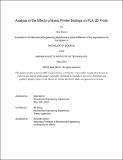Analysis of the Effects of Basic Printer Settings on PLA 3D Prints
Author(s)
Morch, Nine
DownloadThesis PDF (6.569Mb)
Advisor
Deng, Sili
Terms of use
Metadata
Show full item recordAbstract
Desktop-size 3D printers are capable of producing functional prints for an extremely wide variety of designs, but many hobbyist printers still struggle with print defects such as warping, stringing, and blobbing appearing on their prints. There are many existing recommendations for dealing with any of these problems, but some of those recommendations involve materials or resources that hobbyist printers may not have access to, such as printer-specific filament or a heated environment. This thesis investigates how problems such as warping, blobbing and stringing can be affected by changing basic print settings that should be available on all slicing softwares and printers: nozzle temperature, bed temperature, flow rate, and print speed. Blobbing can be caused by the flow rate being too high or the print speed being too low, and is also present around the corners of parts when the nozzle or bed temperatures are too high. Stringing is very print-path-dependent, but may be lessened by lowering the nozzle temperature. Warping is strongly a function of both nozzle and bed temperature, and increasing temperatures will decrease warping. However, increasing bed temperature too high will start to cause uneven cooling, and the bottom of the part will shrink compared to its nominal dimension. The experiments conducted for this thesis find that starting a PLA print with default values of 200°C nozzle temperature, 60°C bed temperature, 100% flow rate and 50 mm/s print speed, then slowly incrementing the values to fix the most evident problems, will provide the best quality print.
Date issued
2023-06Department
Massachusetts Institute of Technology. Department of Mechanical EngineeringPublisher
Massachusetts Institute of Technology